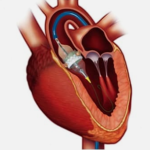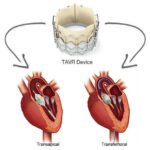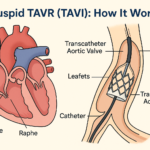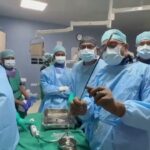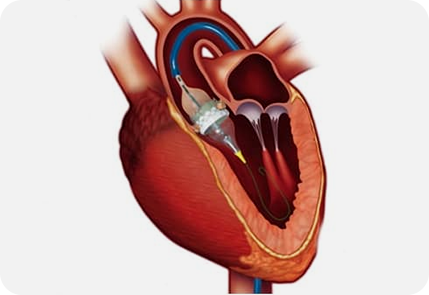 21 October, 2024
21 October, 2024
Discover the Best TAVR and TAVI in India: A Revolutionary Approach to Heart Valve Replacement
In the realm of cardiac surgery, the Best TAVR and TAVI in India offer a groundbreaking alternative to traditional open-heart surgeries. Dr. AB Gopalmurugan sheds light on the minimally invasive transcatheter valve replacement procedures that not only enhance recovery times but also improve patients’ quality of life.
Table of Contents
- Introduction to Open Heart Surgery
- The Emergence of Transcatheter Heart Valve Replacement
- Types of Valve Replacements: TAVR vs TAVI
- Dr. AB Gopalmurugan’s Contributions to Heart Valve Replacement
- Guinness World Record Achievement
- The Future of Heart Valve Replacement
- Conclusion: Choosing the Right Procedure
- FAQs about TAVR and TAVI
Introduction to Open Heart Surgery
Open heart surgery is a complex procedure aimed at correcting various heart conditions. Typically, it involves making a large incision in the chest to access the heart. This approach allows surgeons to perform repairs or replacements of heart valves, arteries, or other structures.
Patients often face extensive recovery times, with hospital stays averaging between seven to ten days. This can be particularly taxing for elderly patients, who may struggle to regain their previous quality of life post-surgery.
Challenges of Open Heart Surgery
While open heart surgery has been a life-saving intervention for many, it is not without challenges. The procedure itself is invasive, requiring significant physical trauma to the body.
- Long Recovery Times: Patients often experience prolonged recovery periods, which can lead to increased hospital stays.
- Physical and Emotional Toll: The stress of surgery and recovery can impact mental health and emotional well-being.
- Risk of Complications: As with any major surgery, there are risks of complications, including infections and blood clots.
The Emergence of Transcatheter Heart Valve Replacement
In response to the challenges posed by open heart surgery, the medical community has developed innovative alternatives, such as Transcatheter Heart Valve Replacement (TAVR). This minimally invasive procedure has transformed the landscape of cardiac care.
First introduced in India in 2010, TAVR has revolutionized how heart valve replacements are performed. It offers a less invasive option for patients who may not be suitable candidates for traditional surgery.
What is Transcatheter Heart Valve Replacement?
Transcatheter Heart Valve Replacement (TAVR) is a procedure that allows for the replacement of heart valves without the need for open heart surgery. Instead of a large incision, a catheter is used to deliver the new valve directly to the heart through a small opening, often in the groin.
This technique significantly reduces recovery times and minimizes the physical trauma associated with traditional surgery. Patients can often return home within a few days, resuming their normal activities much faster.
The Procedure Explained
The TAVR procedure involves several key steps:
- Catheter Insertion: A catheter is inserted through a small incision, typically in the groin.
- Valve Delivery: The new heart valve, compressed within a delivery system, is guided through the catheter to the heart.
- Valve Deployment: Once in position, the valve is deployed, replacing the diseased valve without the need for open surgery.
This innovative approach has made it possible for many patients to avoid the lengthy recovery associated with open heart surgery.
Recovery Timeline Compared to Open Heart Surgery
One of the most significant advantages of TAVR is the recovery timeline. In contrast to open heart surgery, which often requires a hospital stay of up to ten days, TAVR patients can expect to be discharged within a day or two.
This rapid recovery allows patients to return to their daily lives sooner, significantly improving their overall quality of life. The minimally invasive nature of the procedure means less pain, reduced risk of infection, and quicker rehabilitation.
- Hospital Stay: TAVR: 1-2 days; Open Heart Surgery: 7-10 days.
- Return to Normal Activities: TAVR: Within a week; Open Heart Surgery: Several weeks to months.
- Post-Operative Pain: TAVR: Minimal; Open Heart Surgery: Significant.
Types of Valve Replacements: TAVR vs TAVI
When considering heart valve replacement, two primary options arise: TAVR (Transcatheter Aortic Valve Replacement) and TAVI (Transcatheter Aortic Valve Implantation). While these terms are often used interchangeably, they do have distinct meanings.
TAVR specifically refers to the procedure used for replacing the aortic valve, while TAVI encompasses a broader range of transcatheter procedures, including those for mitral and other heart valves. Both procedures share the same minimally invasive approach, but they cater to different patient needs based on the valve affected.
Key Differences
- Indications: TAVR is typically indicated for patients with severe aortic stenosis, while TAVI can be used for a variety of valve replacements.
- Complexity: TAVI procedures, especially those involving the mitral valve, tend to be more complex than TAVR.
- Recovery: Both procedures offer quicker recovery times compared to traditional surgery, but TAVR patients often see faster outcomes due to the simplicity of the procedure.
Ultimately, the choice between TAVR and TAVI depends on the specific condition of the patient and the valves involved. Consulting with a specialist is crucial to determine the best approach.
Dr. AB Gopalmurugan’s Contributions to Heart Valve Replacement
Dr. AB Gopalmurugan has been a pioneer in the field of transcatheter heart valve replacement in India. His commitment to advancing cardiac care has led to significant innovations and successful outcomes for patients across the country.
Since introducing TAVR to India in 2010, Dr. Gopalmurugan has performed hundreds of procedures, showcasing his expertise and dedication to providing the best possible care. His work has not only improved the lives of individual patients but has also contributed to the broader acceptance and implementation of minimally invasive valve replacement techniques in India.
Impact on Patient Care
Dr. Gopalmurugan’s efforts have made heart valve replacement accessible to many who previously faced the daunting prospect of open-heart surgery. His leadership at the Heart Valve Center has fostered a team of skilled specialists, ensuring high-quality care for patients.
Through extensive training and collaboration, Dr. Gopalmurugan has elevated the standards of heart valve replacement procedures, making him a respected figure in the medical community.
Guinness World Record Achievement
In a remarkable feat, Dr. Gopalmurugan and his team achieved a Guinness World Record by performing 20 TAVR surgeries within a single hour. This unprecedented event showcased not only their skill but also the effectiveness of transcatheter procedures in saving lives.
The record-breaking initiative involved coordinating with 20 leading heart centers worldwide. Each center performed a TAVR procedure simultaneously across different time zones, highlighting the global impact of this innovative approach to cardiac care.
Significance of the Achievement
This achievement serves as a testament to the advancements in modern medicine and the potential of minimally invasive techniques. It emphasizes the importance of collaboration and innovation in addressing the ongoing challenges of heart disease.
By successfully executing this initiative, Dr. Gopalmurugan and his team have raised awareness about TAVR and its benefits, encouraging more patients to consider this efficient alternative to open-heart surgery.
The Future of Heart Valve Replacement
The future of heart valve replacement looks promising, with ongoing research and technological advancements paving the way for even more effective treatments. As the medical community continues to explore new techniques, the focus remains on improving patient outcomes and minimizing risks.
Emerging technologies, such as improved valve designs and enhanced imaging techniques, are set to further refine the TAVR and TAVI procedures. These innovations aim to increase the success rates and expand the patient population eligible for these minimally invasive options.
Potential Developments
- Expanded Indications: Future advancements may allow TAVR and TAVI procedures to be performed on a broader range of patients, including those with more complex conditions.
- Improved Devices: Ongoing research into valve materials and designs aims to enhance durability and performance.
- Telemedicine Integration: The integration of telemedicine in pre- and post-operative care can streamline patient management and improve outcomes.
The continuous evolution of heart valve replacement techniques promises to enhance the quality of care and ultimately save more lives.
Conclusion: Choosing the Right Procedure
Choosing the right heart valve replacement procedure is crucial for optimal patient outcomes. With options like TAVR and TAVI available, patients must work closely with their healthcare providers to determine the best course of action based on their individual conditions.
Factors such as age, overall health, and the specific type of valve disease play significant roles in this decision-making process. A thorough evaluation by a specialist can help guide patients toward the most suitable procedure.
Empowering Patients
Education plays a vital role in empowering patients to make informed decisions about their heart health. Understanding the differences between TAVR and TAVI, along with the associated risks and benefits, can help patients advocate for their needs and preferences.
As the landscape of cardiac care continues to evolve, patients can feel hopeful knowing that less invasive options like TAVR and TAVI are reshaping the future of heart valve replacement in India and beyond.
FAQs about TAVR and TAVI
What is the difference between TAVR and TAVI?
TAVR refers specifically to Transcatheter Aortic Valve Replacement, while TAVI is a broader term that includes various transcatheter valve replacement procedures.
Who is a candidate for TAVR?
Candidates for TAVR typically include patients with severe aortic stenosis who are at high or intermediate risk for open-heart surgery.
What is the recovery time for TAVR?
Patients undergoing TAVR can often expect to be discharged within 1-2 days post-procedure, with many returning to normal activities within a week.
Are there any risks associated with TAVR?
As with any medical procedure, TAVR carries some risks, including bleeding, infection, and valve-related complications. However, these risks are generally lower compared to traditional open-heart surgery.
How can I find the best TAVR and TAVI in India?
Consulting with a qualified cardiologist or cardiac surgeon who specializes in transcatheter procedures is the best way to find the best TAVR and TAVI options in India.





